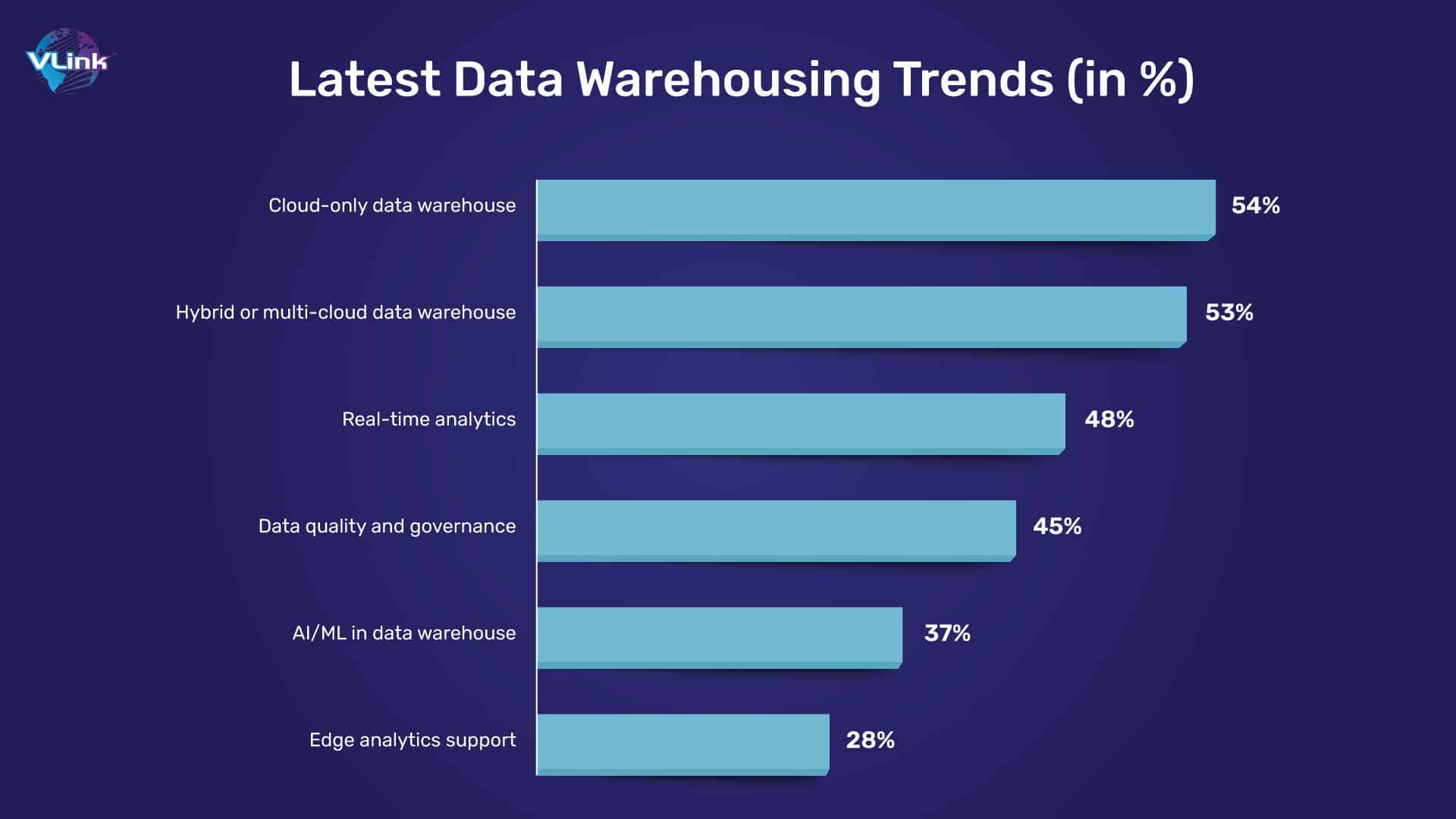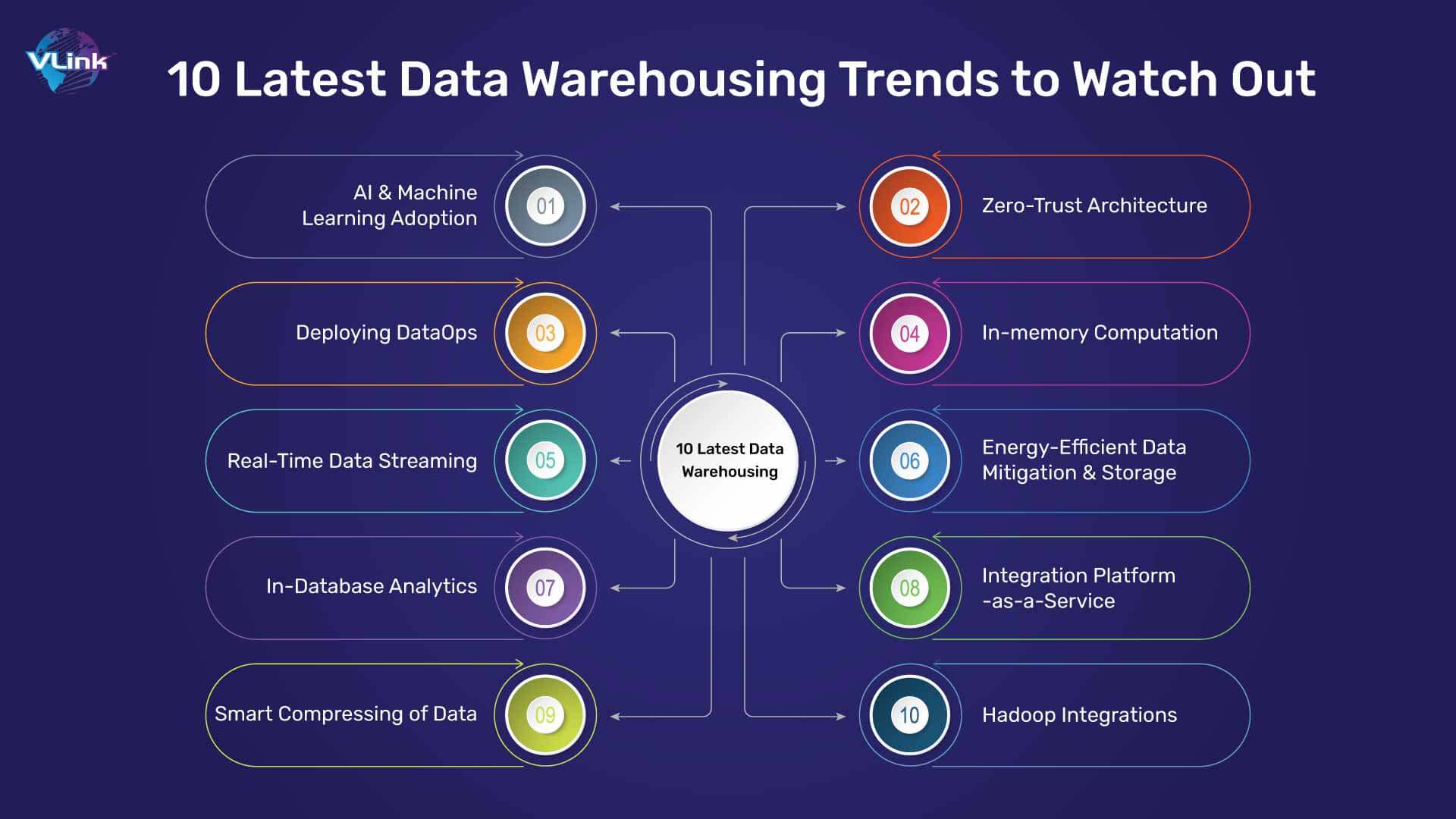3.5 quintillion bytes of data was created every day in 2023.
And undoubtedly, that number is continuously on the rise.
Enterprises that can manage the power of big data can stay ahead of the curve. But processing, storing, and identifying a large amount of data is an incredible challenge. This is why the data warehouse market is developing rapidly.
A data warehouse supports business intelligence (BI) activities, especially analytics to manage data. These tools make it possible to manage and analyze significant data without hassle.
Data warehousing is consistently evolving from data analytics to cloud-based tools like BigQuery and Snowflake. Knowing the latest data warehouse trends is essential to outwit your competitors in today's cutting-edge world.

In this blog, we'll talk about the trending data warehouse solutions to watch out for in the future and the current era.
10 Data Warehouse Trends to Watch Out

1- AI & Machine Learning adoption for intelligent operations
AI and machine learning(AI/ML) are widely used in practical applications across many sectors. AI can help with everything from insurance claims management to supply chain optimization and fraud detection.
- Discovers relationships.
- Evaluates potential outcomes.
- Routine choices are automated.
Despite the gains such technologies provide, data practitioners understand large-scale automation may exacerbate the problem of poor data integrity. As the volume of data being handled grows, organizations increasingly need to shift data operations to quicker machine learning-enabled AI systems.
AI/ML algorithms can only provide credible insights if trained on large amounts of accurate, consistent, contextualized data. Systems educated on faulty data may generate erroneous suggestions or wrong conclusions, which might have severe consequences.
2- Zero-Trust Architecture for Enhanced Data Security
Nearly 85% of the business leaders in the study said they believe cyber risks are growing, and only 35% say their companies are adequately protected. When IT staff and decision-makers were asked about the most important aspects of data management and storage for the next three years, 61% rated data protection and availability as one of their most important factors.
Here are the various data types that are recognized as most critical for breaches and thefts:
Categorization of types of data and their significance
This approach differs from traditional cybersecurity models in which users can go anywhere in the network once granted initial access.
With zero-trust architecture, every network and user interaction is authenticated, authorized, and validated. Because ransomware attacks are increasingly focused on data backups, creating immutable backups is another strategy companies use to avoid a data crisis.
Zero-trust architecture works through the write-once-read-many (WORM) mechanism—as employees upload files, they set an immutability flag that locks them in place for a set period. The data is frozen for that specified duration.
3- Deploying DataOps for continuous improvement
DataOps is a collection of technologies, processes, and best practices that combine a process-focused approach to data with the automation methods of the Agile software development methodology to improve speed and quality while fostering a collaborative culture of rapid, continuous improvement in the data analytics field.
DataOps strategies share these common elements:
- Collaborative interactions between businesses & data scientists
- A flexible and customized data development environment.
- Fast optimizations and automated processes.
- Ensuring quality of data through automated testing.
- Accurate monitoring and reporting of analytical processes.
DataOps employs lean and agile principles like continuous development and testing to optimize data flow communication, integration, and automation, resulting in more predictable data delivery.
In addition, it provides IT experts, data engineers, data scientists, and data analysts with information about their testing outcomes, allowing them to iterate viable product solutions swiftly. Consequently, organizations can get their data analytics apps up and operate considerably faster than before, giving them a competitive advantage.
4- In-memory Computation for Faster Outcomes
Clusters of servers are used for in-memory computing to pool the total available RAM and CPU power. This architecture spreads data handling and processing responsibilities throughout the cluster, dramatically increasing performance and scalability.
Although initially popularized in the financial services industry, in-memory computing has seen tremendous development amid the recent transition to remote work. It has also emerged as a trend in data warehousing.
The importance of IMC will continue to increase over the coming years as ongoing development and new technologies become available, including:
The significance of in-memory computation is increasing every year, and the following advances are available to deploy this data warehouse trend:
- Support for distributed SQL – which includes ANSI SQL-99 support, minimizing the occurrence of manual errors through inappropriate queries.
- Non-volatile memory (NVM) - helps prevent fault tolerance through software applications, enabling predominant computing storage.
- Hybrid Models for storing large datasets – supports a universal interface for platforms, RAM, in-memory spaces, and disks to adjust processing performance and storage strategies.
- Record-maintaining platforms –to support hybrid transaction & analytical processing (HTAP) with persistent storage layers for flexible and quick information access.
Because of the continuous work-from-home practices that many organizations have embraced, this data warehouse trend has established a permanent practice across all industries.
5- Real-Time Data Streaming
Data freshness and latency standards have become closer to real-time as data demands have changed. We will witness the growth of solutions that simplify the difficulty of programming code to construct real-time streaming pipelines in areas such as banking, e-commerce, and manufacturing.
Data warehouse solutions like Snowflake enable organizations to prep, merge, enhance, and query streaming data sets in SQL, which they say has a 12x better price performance than a typical data warehouse. Snowflake has also refactored its Kafka connector so that as data arrives, it has faster query processing, resulting in a 10x reduction in latency.
6- Energy-Efficient Data Mitigation & Storage
While the amount of data steadily increases, so does the energy required to store it all. These massive air conditioning requirements use over 40% of a data centre's power.
Data centres create a lot of heat, and extensive cooling is necessary for all the gear to work correctly. These massive air conditioning requirements use over 40% of a data centre's power. And that's where green data storage is born.
Cloud data warehousing is increasingly being included in energy-saving programs for enterprises. It's encouraging to see a green data warehouse trend emerge as we work to combat climate change. Switching to a green data warehousing solution like a cloud data warehouse and cloud managed infrastructure services may provide other advantages besides energy savings. It suits the environment and will lower your organization's carbon impact.
7- In-Database Analytics
In-database analytics is a type of data analysis within the confines of a database or data warehouse. After transfers, in-database analytics are embedded into the storage architecture and replace the usage of external programs. How do database analytics work?
By doing operations on the database rather than the BI tool, you eliminate the resource-intensive pull phase, and you now have portable code within the database that you can transfer to another tool.
Regarding security, the database and your BI tool communicate only the modelling, query, and results. Performing data analytics procedures on the inside decreases data movement, bandwidth overhead needs, and security concerns associated with disseminating sensitive data across various sites and devices.
8- Integration Platform-as-a-Service (IPaaS)
Large companies use Integration Platform-as-a-Service (IPaaS) to combine data and applications that reside on-premises and in public and private clouds. This enables developing and deploying complicated integration projects involving two or more connections to SaaS as a technology connector for common databases.
Traditional ETL combines data from many systems into a single database, data store, or data warehouse for analysis and decision-making. iPaaS systems communicate data through API endpoints and provide security through API rules such as data and authorization.
9- Smart Compressing of Data
As organizations stockpile more data, they have recognized the need to compress and conserve storage space. Companies increasingly rely on compression techniques to minimize rising storage costs as their data grows.
Data compression reduces the number of bits (binary digits) required to hold data. It first establishes reference libraries for binary data's 1s and 0s, then replaces lengthier strings with shorter reference tags. Data compression helps free up storage capacity, speeds up data transfers, and lowers overall storage expenses. That is why it has been one of the most popular data warehouse trends for quite some time and is likely to continue.
10- Hadoop Integrations
The open-source Hadoop application excels at processing massive data volumes with its distributed file system (Hadoop DFS) and parallel MapReduce paradigm.
As a result, Hadoop is an excellent complement to "standard" data warehouses. This explains why many data warehouse managers use Hadoop to handle some of the most demanding workloads.
The application's popularity has risen and fallen over the previous decade, but it has recently seen a resurgence in recent data warehouse trends.
How to Choose the Best Data Warehouse Trend?
Large businesses and IT executives are striving to establish and own a cloud strategy for data storage to shift some or all of an organization's data warehouse architecture to the cloud.
Here are some technological considerations that will help you choose the best data warehouse trend:
- The biggest public cloud providers provide various data-related services and are constantly innovating. There are also other third-party choices to consider.
- Your data-related technology choices and the implementation plan must be consistent with the business strategy and goals. Examining the capacity to support or transfer your existing data moves, ETLs, and security model is also necessary.
- Using a partner with a cloud platform and data transfer knowledge are frequently things to consider. This is particularly true when it comes to technology selection and relocation planning.
- Databases cannot match company demands for flexibility and computational power, and a standard data warehouse could be more efficient for most firms.
- Cloud data warehousing has emerged as the most excellent choice for businesses seeking to make informed decisions while remaining competitive.
VLink's Data Warehouse Experts Are Here to Help You!
Developing hyper-scale data warehouses with computational solid power and large storage capacity will become crucial with the proliferation of data sources and kinds.
The integration of cloud computing technologies with data warehousing and the availability of low-cost big data solutions will continue to change how businesses use data analytics services.
VLink offers multiple benefits from end-to-end data engineering and analytics across verticals while helping you pick the proper methodology and expedite data intelligence transformation by engaging with the latest data warehouse trends in the market.
Get rid of data-related problems by deploying the most effective and advanced data warehouse solutions for VLink!









 Shivisha Patel
Shivisha Patel

















